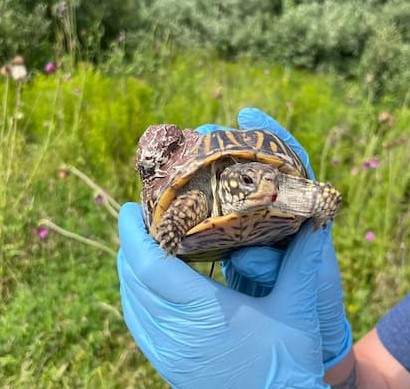Welcome back! Today we wanted to talk about how we use radio telemetry to track ornate box turtles, as this year we have been and will continue to track 50 turtles over the active season! When we head into the field for the first time during the field season, we bring the turtle dogs with us to initially find the turtles. At each ornate site, 5-10 qualifying turtles receive a transmitter, which is attached to the carapace of the shell using epoxy. We want to make sure the turtles that receive a transmitter are large enough that the extra weight will not bother them.

Ornate box turtle with a telemetry transmitter on her carapace. Note the face of a lady who was munching on berries!

Our telemetry receiver can tune into frequencies specific to every turtle’s transmitter.
Each month, we track and get samples from the turtles that we have placed transmitters on. Every transmitter has its own frequency, which our radio receiver can be tuned to in order to pick up the signal from individual turtles. An antenna is pointed in different directions at the field site until we hear a rhythmic beep. We then follow the beeping until it gets louder and faster, which tells us that we are getting closer to the turtle. It’s basically a big game of hot and cold! When the beeping becomes really fast and chirpy, similar to a smoke detector with low battery, we know the turtle is near and it’s time to start looking at the ground! After we find the box turtle, we do our exam, take demographic measurements, and collect samples from them. Then, it is time to do it again for the next turtle!
However, telemetry tracking comes with a set of challenges, many that we experienced this week such as…
- Forgetting our antenna and realizing after reaching our destination site 2 hours away
- Turtles residing in poison ivy, brambles, cacti, and thorns, meaning we had to follow them into it
- Transmitters falling off turtles, meaning we ended up searching for a tiny transmitter on the ground; nearly but not impossible
- Predators stealing transmitters off turtles and taking them into inaccessible places
- Turtles walking onto private property that we could not follow them onto
- Transmitter batteries dying
- Bouncing signals due to obstructions like trees, hills, and railroads, meaning we walk in circles following a never-ending beep that leads to nowhere

Our telemetry antenna that leads us to the turtles! Hold it horizontally for a broad signal, vertical (like in the picture) for a more focused signal, and point it at the ground when the turtle is very near!
Don’t get me wrong, though! Finding a turtle in the midst of all of these obstacles feels like winning the lottery! This week, we found turtles traveling to areas we haven’t seen them occupy and gathering our data to help future turtle generations makes it all worth it!!
